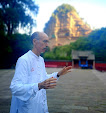


We left Leshan and our driver headed to Emei Shan. Emei Shan is 130km southwest of Chengdu and is one of the four famous Buddhist mountains (the others are Wu Tai Shan, Jiu Hua Shan, and Putuo Shan). Emei Shan rises 10,226 feet and is a Unesco World Heritage Site. We started off with a two hour bus ride up the mountain taking only small backpacks with a change of clothes. Our suitcases were left behind. The drive was beautiful with mountain streams and bamboo blending into the mountain scenery. We made a stop or two on the way where I took pictures of beautiful specimens of wild Ganoderma (Japanese: Reishi mushroom) that were for sale. Wild Ganoderma is rarely available in the USA these days. Almost ganoderma imported into the USA is cultivated and is of uniform size and shape so seeing wild ganoderma (and from a special mountain at that) was a real treat.
I also spotted fresh Pseudoginseng (Chinese: San Qi or Tian Qi) which is an important herb for stopping bleeding. Usually when we buy Pseudoginseng here in the US the color is dark black. There were lots of other specimens of herbs for sale in the store which made in quite interesting for me.
When we reached our stopping point we then took a half hour hike up the mountain until we got to the cable lift which took us to a hotel at approximately 10,000 feet. At the top the air was cool and fresh and we were glad to have brought our jackets. We took about 15 minutes to get settled in our rooms and then headed up to the top to see the Golden Summit Temple (Jinding Si).
Top Right and Left: Ganoderma (Reishi).
Bottom: Pseudoginseng (San qi or Tian qi).
For more information on Emei Shan, click on this link:




















